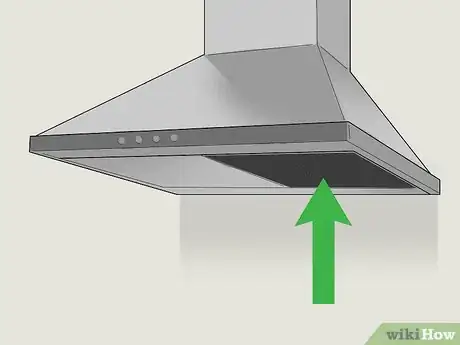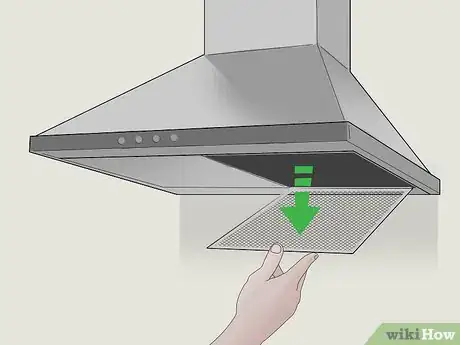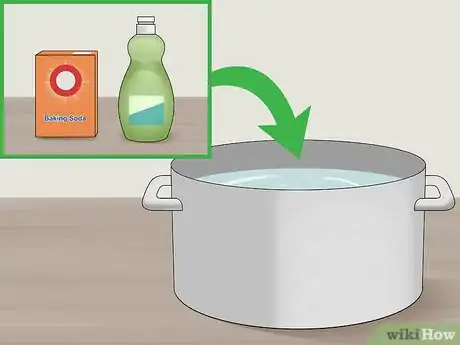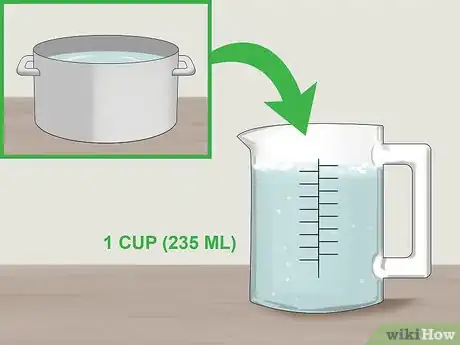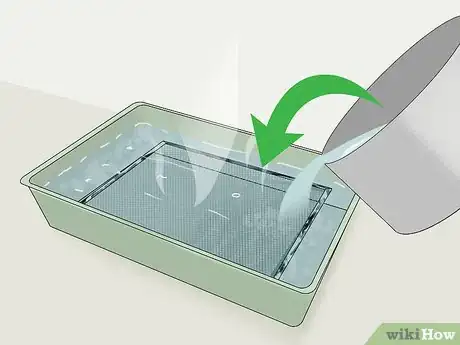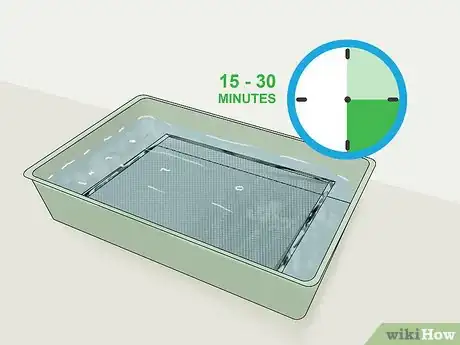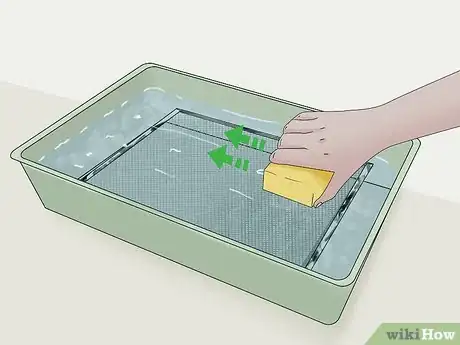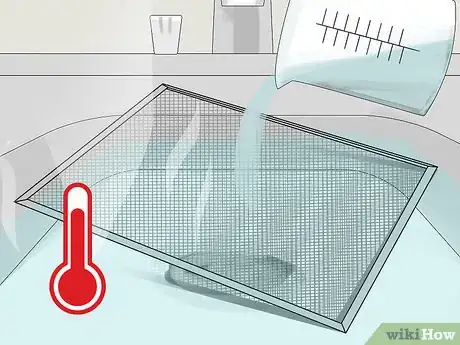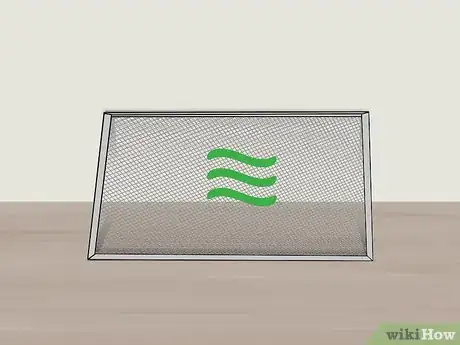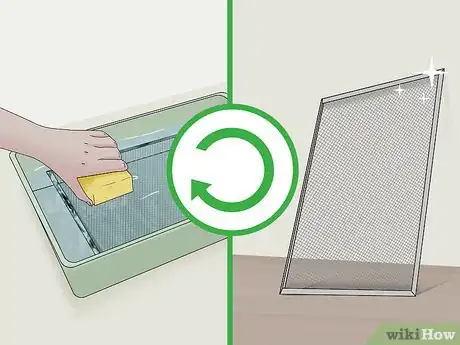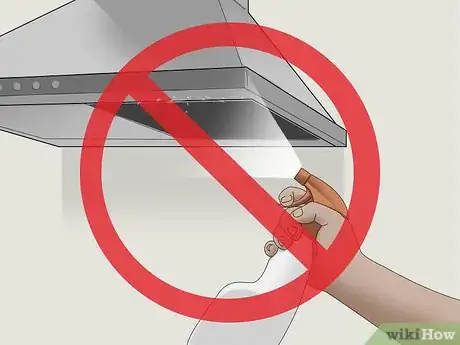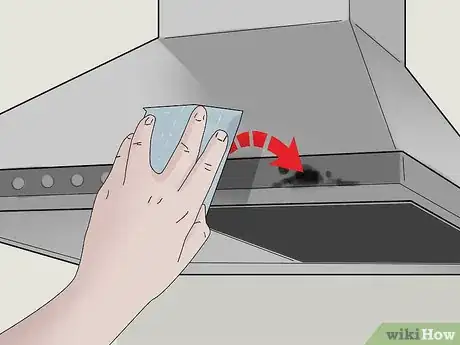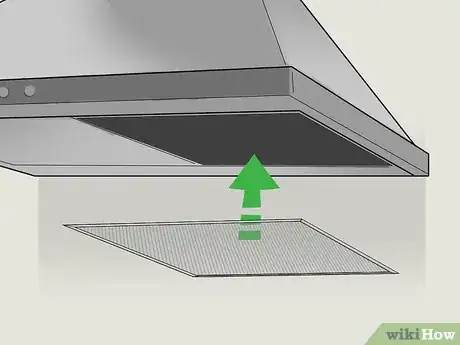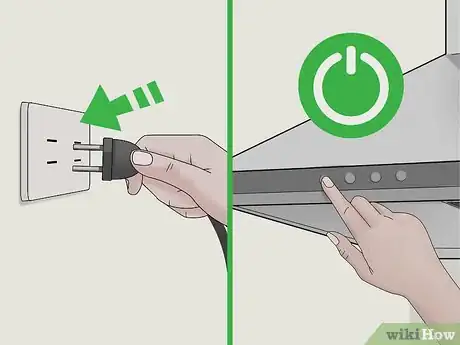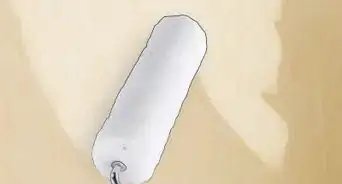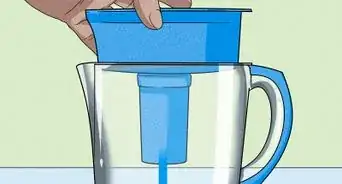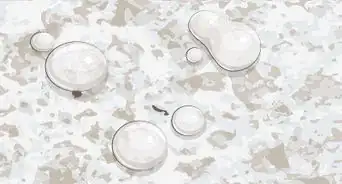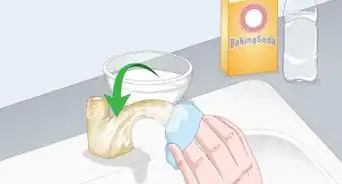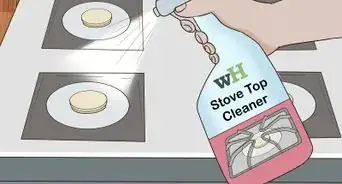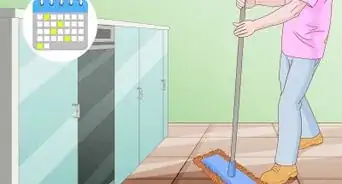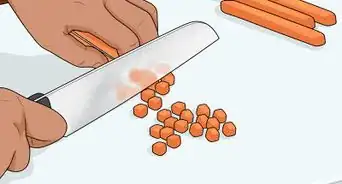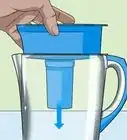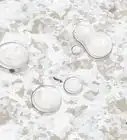This article was co-authored by Raymond Chiu. Raymond Chiu is the Director of Operations for MaidSailors.com, a residential and commercial cleaning service based in New York City that provides home and office cleaning services at affordable prices. He has a Bachelors in Business Administration and Management from Baruch College.
This article has been viewed 83,187 times.
A kitchen exhaust fan removes grease, smoke, steam, and odors from the air as you cook. Over time, this grease and debris builds up in the filter, and slowly starts decreasing the effectiveness of your fan. If enough time passes between cleanings, a clogged grease filter can become a dangerous fire hazard. Thankfully, cleaning your kitchen exhaust fan can be done quickly, and easily, with common household supplies.
Steps
Removing the Grease Filter
-
1Turn off and unplug the exhaust fan. During this cleaning process you will be working close to the electrical components of your exhaust fan. To minimize the risk of injury, fully unplug the exhaust unit before proceeding. In the event of faulty wiring or a broken switch, simply turning the fan off does not cut out electricity from every part of the appliance.
-
2Locate the grease filter. Grease filters are rectangular, and made of metal mesh. They are located on the underside of the hood or microwave exhaust fan. If you have trouble finding your grease filter, consult the owner’s manual, or visit the manufacture’s website and find information for your specific make and model.
- Modern microwave systems sometimes have a small charcoal filter on top of the unit which filters out odors. This filter should be replaced every 6-12 months, depending on use.
Advertisement -
3Remove the grease filter.[1] Unhook any levers or tabs that are holding the filter in place and gently pull the dirty filter out. Most filters will come out with little effort, but heavy grease build up may cause some filters to stick. Sliding a butter knife around the edge of the filter is an easy way to loosen up a stubborn filter.[2]
-
4Place the grease filter in a pan or container. This will be the pan you are soaking and cleaning the filter in.[3] The pan should be deep enough to fully submerge the filter in the cleaning solution. The average sheet pan is perfect for most grease filters.
Cleaning the Grease Filter
-
1Slowly add baking soda and dish soap into a large pot of water. Both baking soda and dish soap help grease dissolve in water.[4] Combining both ingredients creates a non-toxic cleaning solution that quickly and effectively breaks down tough grease build-up.[5]
- Adding the baking soda slowly, to cool water, will prevent it from fizzing up over the top of your pot.[6]
-
2Bring the water to a boil. The hot water will help loosen the grease, allowing the cleaning solution to fully penetrate into the filter. Remove the water from the heat as soon as it starts to boil; too much agitation will create bubbles from the dish soap, which can spill over onto your stove.
-
3Set aside 1 cup (235 ml) of the finished cleaning solution. You can use this cleaning solution to remove grease from the exhaust hood and fan blades inside your unit. Extra solution can also be used to easily clean your stove-top and oven.
-
4Carefully pour hot cleaning solution over the grease filter. Pour the solution slowly to prevent backsplash. Keep adding solution until the grease filter is completely submerged. Keep any extra solution warm, in case an additional soak is needed for a filter with particularly serious grease build-up. [7]
- You can soak the filter in the same pot you heated the solution, as long as it is not a non-stick pot. The metal filter will scratch non-stick coating. Most pots are not big enough to completely cover a typical grease filter, so you may need to do half of the filter at a time in order to get the entire filter clean.
-
5Let the filter soak for 15-30 minutes. As the filter soaks, the baking soda and dish soap will slowly dissolve the grease.[8] The dirtier the filter, the longer you should let it soak. If you have not cleaned your filter in years, you may need to let it soak for up to an hour.
-
6Scrub away the grease. Use a non-abrasive sponge or soft bristled brush to scrub away any remaining grease. The grease should come away easily. Avoid scrubbing aggressively to minimize the risk of damaging your filter. If some of the grease is stuck on the filter, repeat the soaking process with clean solution.
-
7Rinse the filter off with hot water. Wash away as much grease and residue as possible. Grease will collect faster on areas of the filter that are still dirty. Starting with a perfectly clean filter will slow down future build-up.[9]
-
8Air-dry your filter completely. You do not want any moisture on your filter when you re-install it. Air-drying, instead of using a cloth or blow drying, will prevent the filter from being damaged. The filter should be completely dry after an hour or 2 of air-drying.[10]
-
9Clean your grease filters regularly. The more you cook, the more often you should clean your grease filters. Regular cleaning will make your exhaust fan operate much more efficiently, and greatly decrease the health and safety risks that grease build-up presents.
Cleaning and Re-assembling the Exhaust Fan
-
1Avoid getting any electrical components of the exhaust fan wet. Never spray cleaning solution into the inner area of the fan – always use a sponge or cloth. Leaving moisture on inner components can result in electrical malfunctions, and will decrease the lifespan of your exhaust unit.
-
2Wipe away any visible grease build-up. Clean the fan blades if they are accessible. Clean fan blades will operate much more efficiently, giving you better ventilation and prolonging the life of your blower unit. Try not to leave any grease on the walls of the hood, or inside the fan. Air-born grease that gets through your grease filter will latch on to the old grease, speeding up dangerous grease build-up. [11]
- For light grease build-up: Use the reserved baking soda solution and a non-abrasive sponge to wipe away any visible grease. If you did not reserve any solution, you can simply mix a spoonful of baking soda and a squeeze of dish soap in with warm water to make an effective de-greasing solution.
- For heavy grease build-up: Apply a thin layer of liquid dishwasher soap, or a Kitchen De-greaser product to the problem areas. Use gloves when applying either product. The thicker cleaning solution will cling to the build-up and slowly break it down. Let the solution soak for 15-30 minutes, and then wipe away grease with a non-abrasive sponge.
-
3Re-insert the clean grease filter. After cleaning the inside and outside of the exhaust fan, you can re-insert the clean, and now dry, grease filter. Simply put the filter back in the same way it was removed. Re-attach any locking mechanisms or screws to secure the filter in place.
-
4Restore power to the exhaust fan. Always plug an electrical appliance into the wall before turning it on. Plug the exhaust fan or microwave back in. Turn the fan on to make sure everything is operating correctly.
Expert Q&A
-
QuestionWhat is the best way to clean up grease?
 Raymond ChiuRaymond Chiu is the Director of Operations for MaidSailors.com, a residential and commercial cleaning service based in New York City that provides home and office cleaning services at affordable prices. He has a Bachelors in Business Administration and Management from Baruch College.
Raymond ChiuRaymond Chiu is the Director of Operations for MaidSailors.com, a residential and commercial cleaning service based in New York City that provides home and office cleaning services at affordable prices. He has a Bachelors in Business Administration and Management from Baruch College.
House Cleaning Professional First, use a cloth or paper towel to wipe away as much grease as possible. This will make cleaning the rest of the surfaces much easier. Next, use a mixture of 1/4 cup/60mL of baking soda and 1 teaspoon/5mL of water and apply it to the greasy surface. You can use a microfiber cloth to gently scrub the area and use a clean, damp cloth to rinse the area after. A couple drops of dishwashing liquid and warm water will also work as a good alternative to baking soda.
First, use a cloth or paper towel to wipe away as much grease as possible. This will make cleaning the rest of the surfaces much easier. Next, use a mixture of 1/4 cup/60mL of baking soda and 1 teaspoon/5mL of water and apply it to the greasy surface. You can use a microfiber cloth to gently scrub the area and use a clean, damp cloth to rinse the area after. A couple drops of dishwashing liquid and warm water will also work as a good alternative to baking soda. -
QuestionHow do you properly clean an oven?
 Raymond ChiuRaymond Chiu is the Director of Operations for MaidSailors.com, a residential and commercial cleaning service based in New York City that provides home and office cleaning services at affordable prices. He has a Bachelors in Business Administration and Management from Baruch College.
Raymond ChiuRaymond Chiu is the Director of Operations for MaidSailors.com, a residential and commercial cleaning service based in New York City that provides home and office cleaning services at affordable prices. He has a Bachelors in Business Administration and Management from Baruch College.
House Cleaning Professional Always clean a cool oven and unplug it if possible. Next, remove the racking or trays and use a non-foam oven cleaner. Spray oven cleaner on a nonabrasive scrub brush and clean the inside of the oven. Once all the areas are clean, wipe down twice with a damp cloth or paper towel until all the cleaner is gone. You can also use the oven cleaner to clean the racks or trays. Remember to rinse until the cleaner is gone.
Always clean a cool oven and unplug it if possible. Next, remove the racking or trays and use a non-foam oven cleaner. Spray oven cleaner on a nonabrasive scrub brush and clean the inside of the oven. Once all the areas are clean, wipe down twice with a damp cloth or paper towel until all the cleaner is gone. You can also use the oven cleaner to clean the racks or trays. Remember to rinse until the cleaner is gone.
Warnings
- Always cut power to electrical appliances before working on them or cleaning them. Simply turning an appliance off is not always enough. As a precaution, always unplug an appliance, or flip the appropriate circuit breaker, before beginning your maintenance.⧼thumbs_response⧽
- Wear gloves and eye protection when working with cleaning chemicals. Even if a solution is non-toxic, it can still cause irritation, or even permanent damage. If exposed, wash your skin or affected orifice thoroughly with water. If irritation persists seek immediate medical attention.⧼thumbs_response⧽
Things You'll Need
- A large pot to heat water
- A sheet pan or container large enough to fit your grease filter
- 1 cup (220 g) of baking soda
- 2 tablespoons (30 ml) of dish soap (not dishwasher soap)
- A non-abrasive sponge or soft bristled brush
- Water
References
- ↑ Raymond Chiu. House Cleaning Professional. Expert Interview. 15 October 2019.
- ↑ https://dengarden.com/cleaning/how-to-clean-range-hood-filters-5-easy-methods
- ↑ Raymond Chiu. House Cleaning Professional. Expert Interview. 15 October 2019.
- ↑ Raymond Chiu. House Cleaning Professional. Expert Interview. 15 October 2019.
- ↑ https://oconto.uwex.edu/files/2011/02/Baking-Soda.pdf
- ↑ https://www.onegoodthingbyjillee.com/2016/01/how-to-clean-a-greasy-stove-hood-filter.html
- ↑ https://www.thekitchn.com/how-to-clean-a-greasy-range-hood-filter-cleaning-lessons-from-the-kitchn-203844
- ↑ Raymond Chiu. House Cleaning Professional. Expert Interview. 15 October 2019.
- ↑ https://www.onegoodthingbyjillee.com/2016/01/how-to-clean-a-greasy-stove-hood-filter.html
About This Article
To clean a kitchen exhaust fan, first you'll need to remove the cover over the grease filter. On some fans, the cover at the base of the fan needs to be unscrewed, but your model may also be spring loaded, covered by baffles that need to be slid off, or have a latch holding it in place. Once you've removed the cover, press the grease filter in to compress the spring or pull on the indentation in the frame of the filter to remove it. Then, fill your sink with hot water and a squirt of dish soap. Set your filter inside of the sink and let it soak for 15 minutes. When it's done soaking, put on a pair of rubber gloves and scrub the filter with a scouring pad or cloth. For hard-to-remove grease, add a few scoops of baking soda to your dish soap and water. Once clean, rinse the grease filter under a stream of cool water to remove any soap or baking soda residue. For the rest of the exhaust structure, scrub the surface of the exhaust and the interior lip of the exhaust vent with a warm soapy sponge. Use a clean, microfiber cloth to wipe away the excess soap and water. Repeat this process at least once a year to keep your grease filter and exhaust fan clean.

